
95% of researchers rate our articles as excellent or good
Learn more about the work of our research integrity team to safeguard the quality of each article we publish.
Find out more
METHODS article
Front. Earth Sci. , 31 January 2024
Sec. Geochemistry
Volume 12 - 2024 | https://doi.org/10.3389/feart.2024.1355494
This article is part of the Research Topic Unconventional Resources: Provenance Analysis, Sediment Transport, Reservoir Evaluation, Geo-energy View all 29 articles
The upper Paleozoic gas reservoir in the Daniudi gas field, Ordos Basin, is one of the typical tight sandstone gas reservoirs in China. Research into the sequential order of reservoir densification and gas accumulation is the key to revealing the formation mechanism of tight sandstone gas reservoirs. However, this scientific issue is still a subject of debate in the Daniudi gas field. Based on a series of reservoir experiments and in combination with stratigraphic burial and thermal maturity history, a comprehensive study is conducted on the formation and natural gas accumulation processes of the upper Paleozoic sandstone reservoir in the Daniudi gas field. Study results indicate that the main causes of sandstone reservoir densification of the study area include long-term compaction, multistage quartz cementation and carbonate cementation. In accordance with the time order of reservoir densification and gas accumulation, the formation of tight gas reservoirs can be divided into two types: self-sourced and near-source accumulations. In the former, before sandstone reservoir densification occurs, low-maturity natural gas generated from coal rocks and dark mudstones enter the reservoir quickly, migrate towards structural highs as driven by buoyancy, and then accumulate and form gas reservoir in favourable lithologic traps. In the latter, after tight sandstone reservoirs are formed, high-maturity gas migrates along fractures formed in the Late Cretaceous and accumulate in the nearby reservoir with micro-fractures. The study results provide a new understanding of the formation process of tight sandstone gas reservoirs and provides a reference for the exploration and development of the same type gas reservoirs.
The Ordos Basin is located in the central north of China; it is the second largest sedimentary basin, with an area of ∼25 × 104 km2. Within the basin, the upper Paleozoic is a main area where tight sandstone gas accumulates, and it has great exploration prospects. At present, five large gas fields with natural gas reserves of >1,000 × 108 m3, namely, Sulige, Daniudi, Uxiqi, Jingbian, and Yulin, have been discovered in the basin (Wang et al., 2015; Sun et al., 2019). Extensive research has been conducted on the natural gas accumulation of upper Paleozoic gas fields in the Ordos Basin, believing that this region is a continuous or quasi-continuous tight sandstone gas field. The gas reservoir is non-buoyancy driven and exhibits widespread gas generation, near-source accumulation and no obvious gas-bearing boundary (Zhang et al., 2000; Dai et al., 2005; Zhang et al., 2007; Zhao et al., 2012; Zou et al., 2013; Lan et al., 2016). With regard to the relationship between reservoir densification and gas accumulation, the general perception is that after tight sandstone reservoirs are formed, natural gas formed in source rocks migrates vertically through fracture systems under excessive pressure and enters reservoirs, gathering near hydrocarbon generation centres (Islam, 2009; Karim et al., 2010; Yang et al., 2012; Xi et al., 2015; Wu et al., 2017). However, a study on the tight sandstone gas reservoir in the Daniudi gas field in the northern basin shows great differences in terms of natural gas migration and accumulation characteristics in different stages of reservoir densification. Based on rock thin section identification, cathodoluminescence (CL), fluid inclusions, C–O isotope assay and source rock geochemical analysis in combination with stratigraphic burial and thermal maturity history, we found the sequence of diagenetic evolution and gas accumulation of the upper Paleozoic sandstone reservoir in the Daniudi gas field. We then propose a model of the formation of tight sandstone gas reservoirs. The findings can guide the research of similar gas reservoirs.
The Daniudi gas field lies in the northeast of the Yishan slope, Ordos Basin, and has an area of 2,000 km2 (Figure 1). The area generally occurs as a flat, gentle, W-dipping monocline, with a dip angle of <1°. Faults are not developed, whereas strata are completely developed within the Daniudi gas field (Zou et al., 2009). In the Carboniferous Taiyuan Fm and Permian Shanxi Fm and Xiashihezi Fm, typical marine–continental transitional facies coal-bearing clastic rocks are developed, which constitute the major horizon for natural gas development in the area. Coal seams and carbon mudstones of the Taiyuan and the Shanxi Fms are main source rocks of natural gas pools. Taiyuan Fm. barrier bars, Shanxi Fm delta front distributary channel sands and Xiashihezi Fm braided river sands are favourable reservoir. Shangshihezi Fm flooding plain lacustrine facies mudstones are the regional cover of upper Paleozoic natural gas reservoirs within the basin (Cai et al., 2005; Fu et al., 2013; Su et al., 2016).

FIGURE 1. Structural location and the main well position of the Daniudi gas field, Ordos Basin. Note: 1: Daniudi gas field; 2: Sulige gas field; 3: Uxiqi gas field; 4: Yulin gas field; 5: Jingbian gas field. In the Daniudi gas field, the major gas pay zone includes Permian braided river reservoirs in the southwest and Carboniferous barrier bar reservoir in the northeast.
Gas exploration practice shows that the upper Paleozoic of the Daniudi gas field from lower upwards includes seven gas-bearing formations (Figure 2). The Mbr 1 and Mbr 2 of the Taiyuan Fm are in a marine–continental transitional facies sedimentary environment; the Mbr 1 and Mbr 2 of the Shanxi Fm are fluvial delta facies; the Mbr 1, Mbr 2, and Mbr 3 of the Xiashihezi Fm are mainly braided river facies. By the end of 2014, the Daniudi gas field achieved a production of 40 × 108 m3 per year, with an accumulative gas yield of >20 billion m3. The major gas pay zone includes braided river reservoirs of the Xiashihezi Fm in the southwest and barrier bar reservoir of the Taiyuan Fm in the northeast. Gas output of the two areas accounts for 90% of the entire gas field (Figure 1).
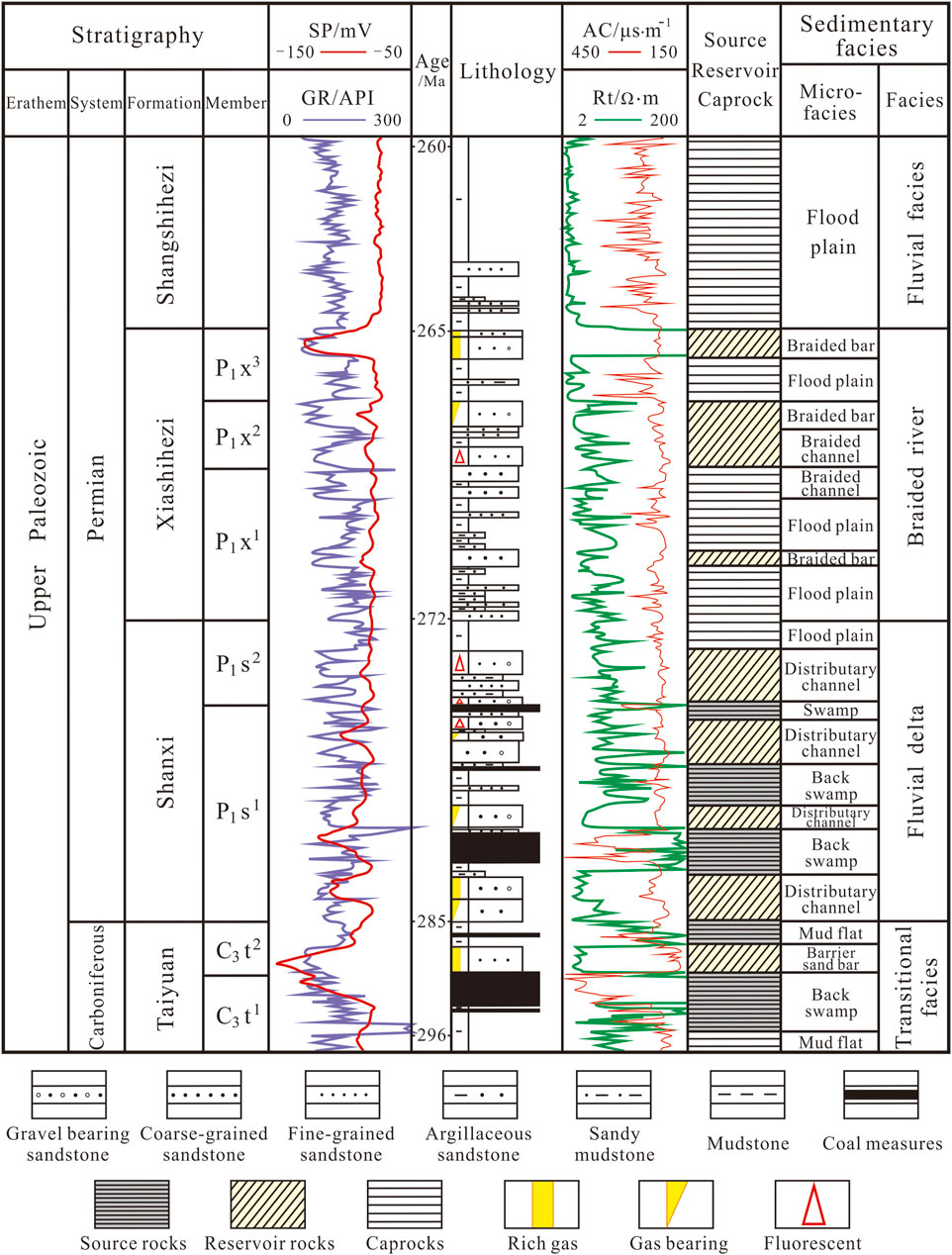
FIGURE 2. Generalized upper Paleozoic stratigraphy of the Daniudi gas field, showing major oil and gas combinations. There are seven gas-bearing formations of the upper Paleozoic in the study area.
The Danudi gas field is the key area of natural gas development in the tight sandstone reservoir of upper Paleozoic in the Ordos Basin. Consequently, a large amount of the drilling for natural gas has taken place in this area, thereby providing core materials, well logs and many other exploration and development data for this study. The data used in this paper were derived from more than 50 wells in the Daniudi gas field. More than 600 rock composition data, 320 grading analysis data, 6,500 reservoir physical property data points and natural gas composition data were obtained from the Exploration and Production Research Institute of Huabei Company, SINOPEC.
A bulk of Upper Paleozoic core samples were selected from the Daniudi gas field and analysed. More than 150 thin sections were created to observe the pore structure and diagenetic phenomena. CL was conducted on 30 thin sections under standard operating conditions by using a Technosyn cathode luminoscope with an EPMA-1600 electron microprobe to determine the stages of cementation. Eighty polished thin sections were made for fluid inclusion petrographic observation and microthermometry analyses to determine the formation of authigenic minerals and diagenetic evolution sequence. In addition, 40 sandstone samples were selected from 18 wells in different formations for stable carbon and oxygen isotopic measurements. A bulk of mudstone samples were crushed for Rock-Eval pyrolysis to obtain the geochemical parameters of source rocks; these parameters mainly include total organic carbon content (TOC), residual soluble hydrocarbon (S1), pyrolysed hydrocarbon (S2), hydrogen index (HI; HI = S2/TOC × 100) and temperature at which the maximum amount of pyrolytic hydrocarbon is produced (Tmax). S1 + S2 reflects the total hydrocarbon generation potential. In addition, the vitrinite reflectance (Ro) of the mudstone was measured by conventional microphotometric methods. All experiments related to this study were conducted in the State Key Laboratory of Petroleum Resource and Prospecting of the China University of Petroleum. The above experimental results can help define the formation of gas reservoir.
The Carboniferous Taiyuan Fm, the Permian Shanxi Fm and Xiashihezi Fm of the upper Paleozoic in the Daniudi gas field are a set of typical marine facies tidal flat–offshore delta–continental braided river sedimentary sequences (Fu et al., 2013; Yang and Liu, 2014), with thick reservoir sands and high lateral continuity (Figure 3). In the sedimentary period of Taiyuan Fm, the area was in an epicontinental sedimentary environment. Large-scale barrier bars formed in the study area, with an extension length of 50 km and a dominant sand thickness varying 6 m–20 m; these barrier bars served as effective pathways for gas migration. In the area with small sand thickness around barrier bars, the reservoir densification is more obvious due to the strong compaction. While the densification of thick sand reservoir is mainly related to the quartz overgrowth. In the period of the Mbr 1 of the Shanxi Fm, the study area was in a coastal plain environment, and shore–delta sedimentary systems were developed. Reservoir sands are mainly distributary channel–underwater distributary channel coarse sandstones, and the sandstone thickness is comparatively large in the western study area. Delta plain sediments were mainly developed in the period of the Mbr 2 of the Shanxi Fm; thick-bedded distributary channel sands are distributed in the centre and north. Similar to Taiyuan Formation, the area with thin sand and high shaliness has strong compaction and strong densification. In the sedimentary period of Xiashihezi Fm, the paleoclimate turned dry and multistage braided sands were superpositioned and mainly developed in the Daniudi gas field (Ren et al., 2007). River channels were thick and migrated frequently, and the reservoir sands were 30–80 m thick. In this period, the thickness of sandstone is large, and the reservoir has strong anti-compaction ability. The reservoir densification of Xiashihezi Fm is mainly caused by multi-stage and multi-type cementation.
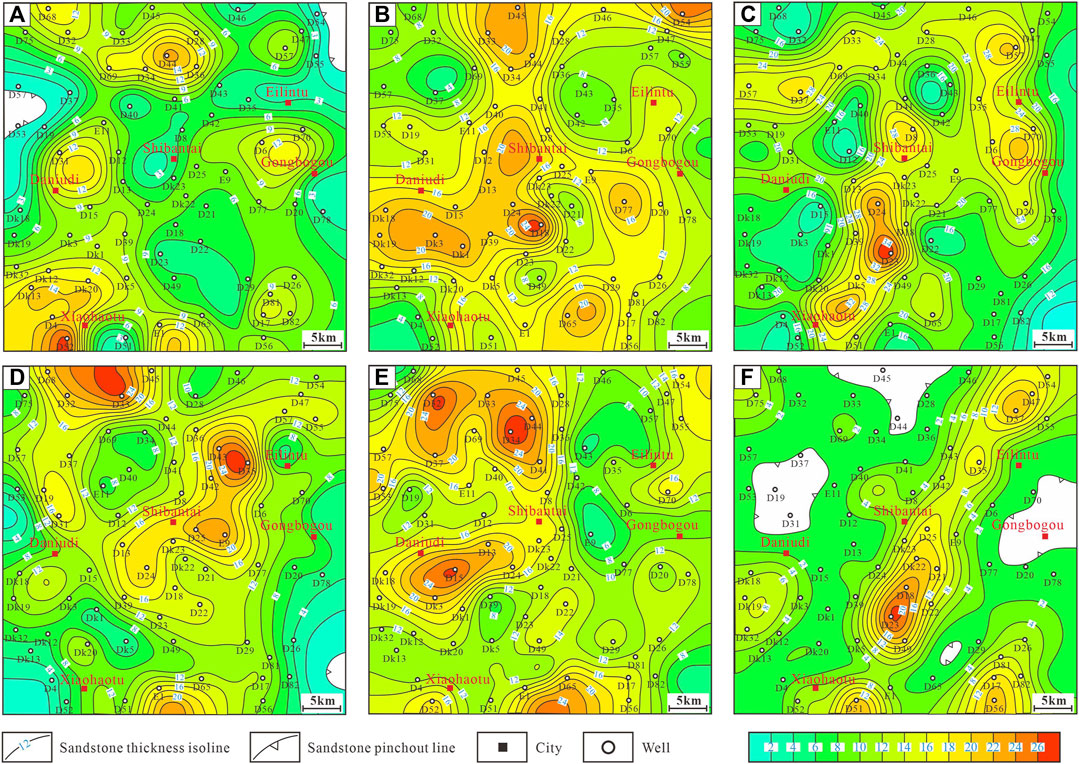
FIGURE 3. Sandstone thickness of the upper Paleozoic reservoir in the Daniudi gas field. Note: (A), Mbr 3 of the Xiashihezi Fm; (B), Mbr 2 of the Xiashihezi Fm; (C), Mbr 1 of the Xiashihezi Fm; (D), Mbr 2 of the Shanxi Fm; (E), Mbr 1 of the Shanxi Fm; (F), Mbr 2 of the Taiyuan Fm.
The upper Paleozoic reservoir rocks of the Daniudi gas field are comprised by medium–coarse-grained lithic sandstone, lithic quartz sandstone and quartz sandstone. The Taiyuan Fm is comprised by quartz sandstone (Figure 4A), while the Shanxi Fm and Xiashihezi Fm are comprised by lithic sandstone and lithic quartz sandstone, with minor quartz sandstone and feldspar lithic sandstone (Figures 4B, C). Clastic quartz includes monocrystalline quartz and polycrystalline quartz; the lithic fragments are mainly epimetamorphic rocks, such as slate and phyllite, with secondary volcanic clasts. The lithic fragments are mostly plastic and underwent intense compaction and then deformation (Figure 5A). Fillings in the reservoirs are mainly matrix and various authigenic cements, with an average content of 10%–15%. The matrix includes argillaceous components, such as kaolinite and illite, with an average content of 8%; the cements mainly include multistage authigenic quartz, calcite and ferrocalcite (Figures 5B–E), with minor ankerite, siderite, chlorite and kaolinite. Microscopy shows that clastic grains have close contact relations, such as linear or concavo-convex, and moderate sorting, subangular and porous cementation (Figure 5F).
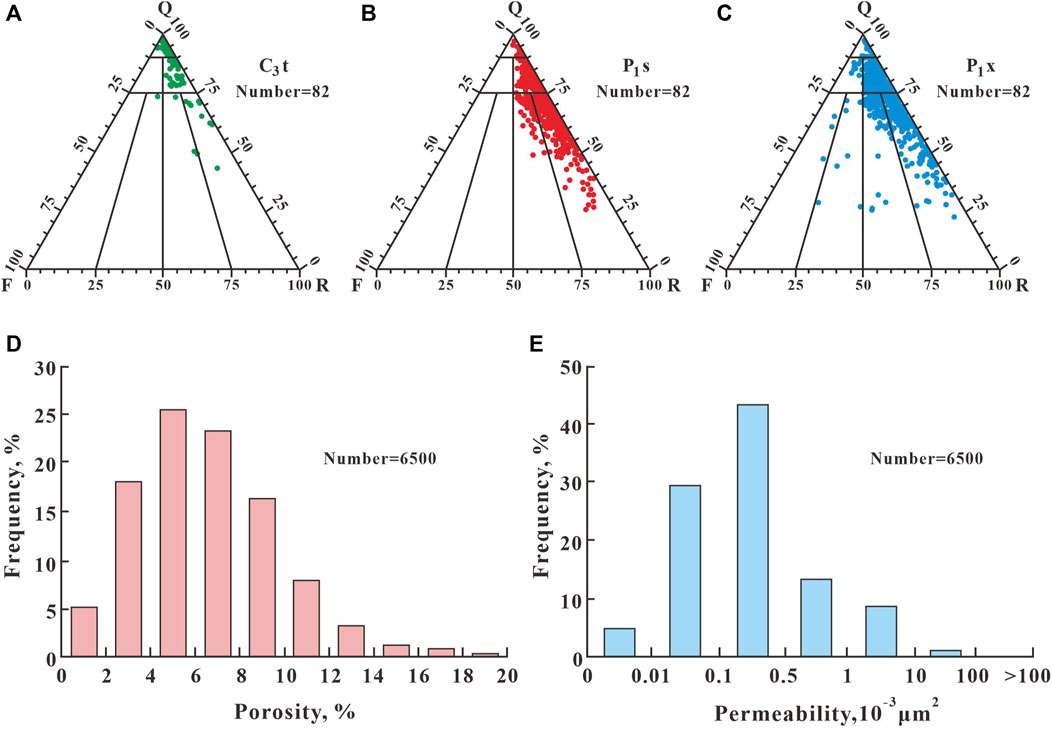
FIGURE 4. Rock composition and reservoir physical property of the Upper Paleozoic tight sandstone in the Daniudi gas field. Note: (A–C), Classification of sandstone using Folk’s (1974) classification, the Taiyuan Formation is dominated by quartz sandstone, and the Shanxi and Xiashihezi formations are dominated by lithic sandstone and lithic quartz sandstone; (D,E), Reservoir porosity and permeability distribution, indicating a low-porosity and ultralow-permeability tight reservoir.
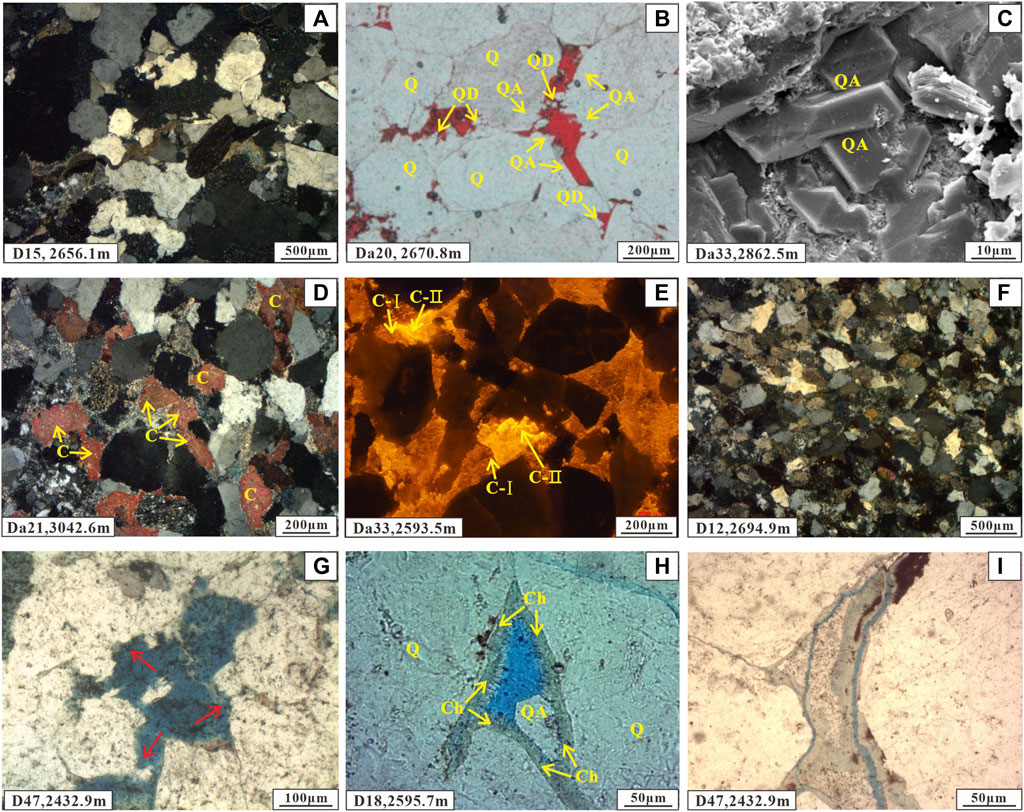
FIGURE 5. The characteristics of reservoir lithology and secondary pore in the Upper Paleozoic tight sandstone reservoir in the Daniudi gas field. Note: (A), Fine-grained sandstone were subject to strong compaction and contacted closely, Crossed Nicol; (B), Moderate-coarse-grained quartz sandstone with multistage quartz overgrowths, Single Nicol; (C), Authigenic quartz occludes primary pores, SEM image; (D), Calcite filled primary pores, Crossed Nicol; (E), Two stages of carbonate cements, Cathodoluminescence image; (F), Fine-medium-grained lithic quartz sandstone, clastic grains have close contact relations, Crossed Nicol; (G), Intergranular dissolved pore and intragranular dissolved pore, Single Nicol; (H), Quartz grains are encapsulated by chlorite film, Single Nicol; (I), Granular boundary micro-fractures, Single Nicol. Q–quartz; QA–authigenic quartz; Ch–chlorite; C–calcite.
In accordance with the statistics of reservoir physical property data, the upper Paleozoic reservoir in the Daniudi gas field has a porosity of 2%–12% with an average of 6.9% and permeability of 0.01 × 10−3–10 × 10−3 μm2 with an average of 0.76 × 10−3 μm2 (Figures 4D, E), indicating a low-porosity and ultralow-permeability tight reservoir. In various gas sets, reservoir properties are mostly favourable in the Mbr 2 and Mbr 3 of the Xiashihezi Fm (Table 1). The upper Paleozoic reservoir underwent long-term diagenetic reworking; the reservoir space are predominantly secondary pores, including intergranular dissolved pores, intragranular dissolved pores and matrix dissolved pores, with secondary residual primary intergranular pores (Figures 5G, H). Secondary pores are mainly quartz-dissolved pores and secondarily feldspar and lithic-dissolved pores, thereby indicating the reservoirs of the study area have two diagenetic fluid environments, i.e., acidic and alkaline. In addition to pores, there are also some micro-fractures in the study area. The micro-fractures are mainly the granular boundary fractures, which are often curved shape and partially dissolved (Figure 5I).
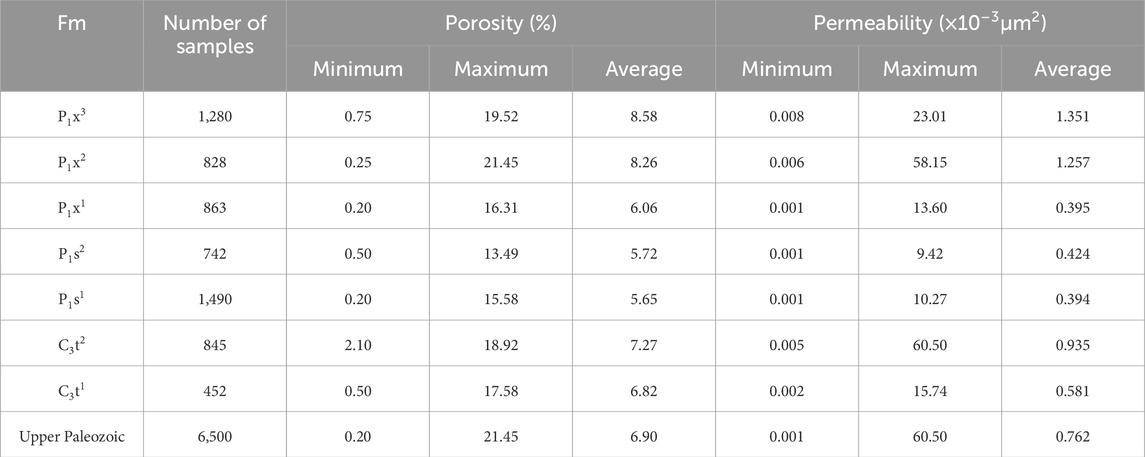
TABLE 1. Porosity and permeability of the Upper Paleozoic sandstone reservoir in the Daniudi gas field, Ordos Basin.
Statistics of mercury-injection parameters imply that the sandstones in the study area have an average pore throat radius of 0.33 μm and a sorting coefficient of throats varying from 0.95 to 5.95 with an average of 3.54. This result suggests that most of the sandstones have poorly sorted pore throats and are dominated by combinations of micropores and microthroats (Table 2). The Carboniferous–Permian reservoir has a displacement pressure varying from 0.01 MPa to 40 MPa; the Xiashihezi Fm has minimum average displacement pressure, followed by the Shanxi Fm and then the Taiyuan Fm This variation tendency reflects that reservoir densification intensifies as the burial depth increases.

TABLE 2. Parameters of mercury injection curves of the Upper Paleozoic sandstone reservoir in the Daniudi gas field, Ordos Basin.
The Carboniferous–Permian reservoir of the Daniudi gas field has a median capillary pressure of 1.04–112.1 MPa. This capillary pressure averages 32.84 MPa in the Xiashihezi Fm, 36.8 MPa in the Shanxi Fm and 19.67 MPa in the Taiyuan Fm, generally displaying opposite characteristics to displacement pressure and decreasing as the burial depth increases. The median pore throat radius averages from 0.007 μm to 0.705 μm, which is 0.12 μm in the Xiashihezi Fm, 0.075 μm in the Shanxi Fm and 0.21 μm in the Taiyuan Fm. The maximum average pore throat radius is found in the Taiyuan Fm, and the minimum average pore throat radius is observed in the Shanxi Fm (Table 2). These findings suggest that the maximum pore throat radius has great influences on displacement pressure, and the median pore throat radius has great influences on reservoir properties.
The upper Paleozoic source rocks of the Daniudi gas field are mainly marine–continental transitional facies coal-measure source rocks, followed by dark mudstones. The organic matter types are mainly III–II type kerogens (Li et al., 2014; Liu et al., 2015; Wu et al., 2017). In accordance with various indexes (organic abundance) of coal rocks and dark mudstones (Figures 6, 7), the coal rocks have an average w (TOC) of 60.55%, average w (chloroform bitumen “A”) of 0.8225%, average total hydrocarbon (HC) of 3,275 μg/g and potential of generating hydrocarbon S1 + S2 of 88.5 mg/g on average. Eighty percent of the samples have the potential to generate hydrocarbon of >50 mg/g; the indexes indicate that the coal rocks are of high quality as source rocks. Organic carbon is widely distributed in dark mudstones; about 75% of the samples have w (TOC)>0.5%, with an average of 1.77%, and about 30% of the samples have W (chloroform bitumen “A”) > 0.05%, with an average of 0.0447%. About 27% of the samples have total hydrocarbon >200 μg/g, with an average of 170 μg/g; about 55% of the samples have the potential to generate hydrocarbon S1 + S2>0.5 mg/g, with an average of 1.5 mg/g. These indexes suggest that dark mudstones contribute to hydrocarbon generation and are of moderately–highly favourable source rocks.

FIGURE 6. The distribution characteristics of organic matter richness index of the Upper Paleozoic coal rocks in the Daniudi gas field. The indexes indicate that the coal rocks are of high quality as source rocks.
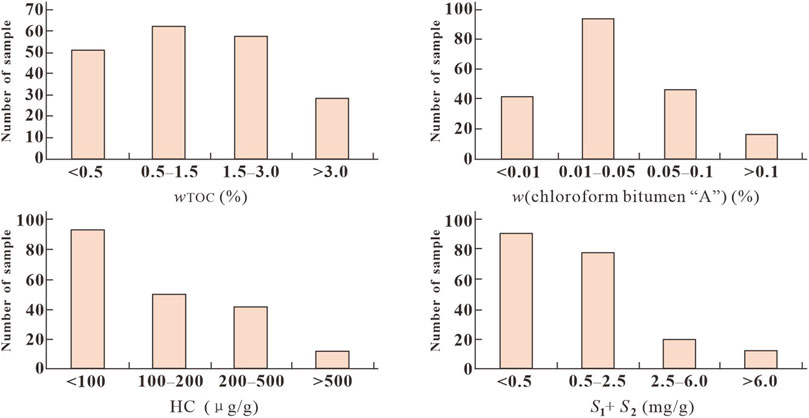
FIGURE 7. The distribution characteristics of organic matter richness index of the Upper Paleozoic dark mudstones in the Daniudi gas field. These indexes suggest that dark mudstones contribute to hydrocarbon generation and are of moderately–highly favourable source rocks.
The upper Paleozoic source rocks are unevenly distributed in the Daniudi gas field; thick-bedded source rocks are chiefly distributed in the southwest (Lu and Miao, 2018). Coal-measure source rocks are 18–30 m thick in the area, and dark mudstones are 35–55 m thick and are a main natural gas generating zone. A comparison of the organic abundance parameters of various Fms and Members of the upper Paleozoic in the Daniudi gas field (Table 3) indicates that the organic abundance indexes of the First Member coal rocks and dark mudstones of the Taiyuan Fm suggest moderately–highly favourable source rocks. The dark mudstones and coals in the Second Member of the Taiyuan Fm have organic abundance indexes higher than those of the First Member and are also a better type. However, because coal rocks are distributed in a small area, their potential to generate hydrocarbon is lower than that of the First Member. The organic abundance of the dark mudstones in the Xiashihezi Fm is slightly higher than that of the Taiyuan Fm, while the organic abundance of coal in the Xiashihezi Fm is slightly lower than that of the Taiyuan Fm. In the plan view, the dark mudstones in the Shanxi Fm have a TOC that is generally higher in the west and lower in the east, and the coals have a TOC that is lower in the centre and higher in the periphery. The dark mudstones in the Shanxi Fm have slightly lower organic abundance indexes, and the strata almost no coal. The Xiashihezi Fm dark mudstones have a TOC that is mostly lower than 0.5% and its organic abundance obviously lower than those of the Taiyuan Fm and the Shanxi Fm, thereby reflecting that the main hydrocarbon-generating horizons of the upper Paleozoic in the Daniudi gas field are Taiyuan and Shanxi Fm source rocks.
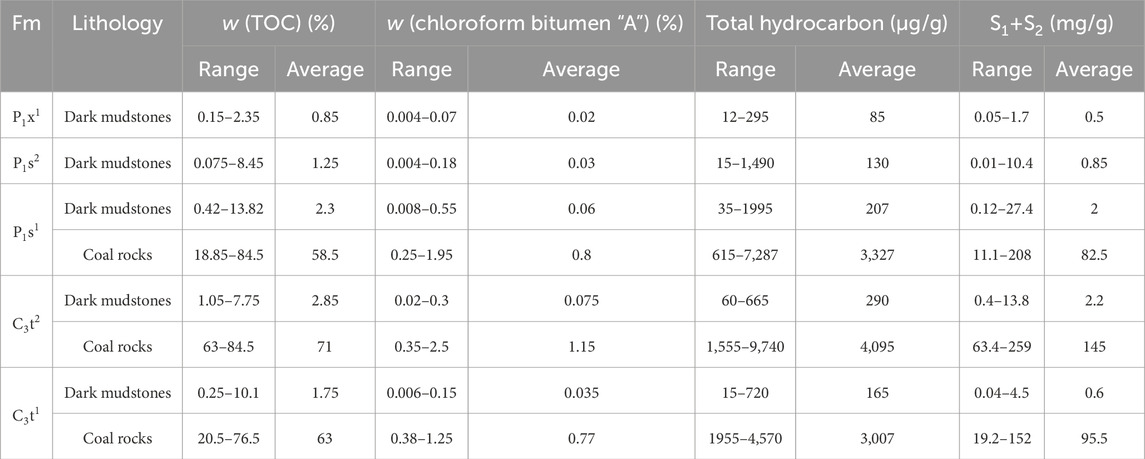
TABLE 3. The organic matter richness of the Upper Paleozoic source rocks of various interval of the Daniudi gas field.
The upper Paleozoic tight sandstone gas in the Daniudi gas field is composed of alkane and minor non-hydrocarbon gases (Table 4). The alkane content ranges from 82.5% to 95.8%, the C2-5 content ranges from 2.2% to 15.3%, and the non-hydrocarbon gases mainly include CO2 and H2, with a content of <5%. The methane content has a positive correlation to aridity coefficient, and the aridity coefficient (C1/C1-4) ranges from 0.845 to 0.977. Natural gas in the Xiashihezi Fm is dry gas, with an aridity coefficient of >0.95, while natural gas in the Taiyuan and Shanxi Fms are comparatively humid, with aridity coefficients of <0.95. The strata near source rocks in Shanxi Fm exhibit greatly increased wet content, thereby reflecting favourable fractionation effects and a high content of near-source heavy hydrocarbon gas. The C isotopic value of methane in the Upper Paleozoic tight sandstone gas varies mainly from −37‰ to −34‰, the C isotopic value of ethane ranges from −26.5‰ to −23.5‰ and the Ro value ranges from 0.5% to 1.5%. Compared with the tight gas in the Sulige and Jingbian gas fields, tight gas in the Daniudi gas field has an obviously lower aridity coefficient, and natural gas is mainly controlled by thermal maturity and not mixed with biogas (Zhao et al., 2014; Yang et al., 2016).
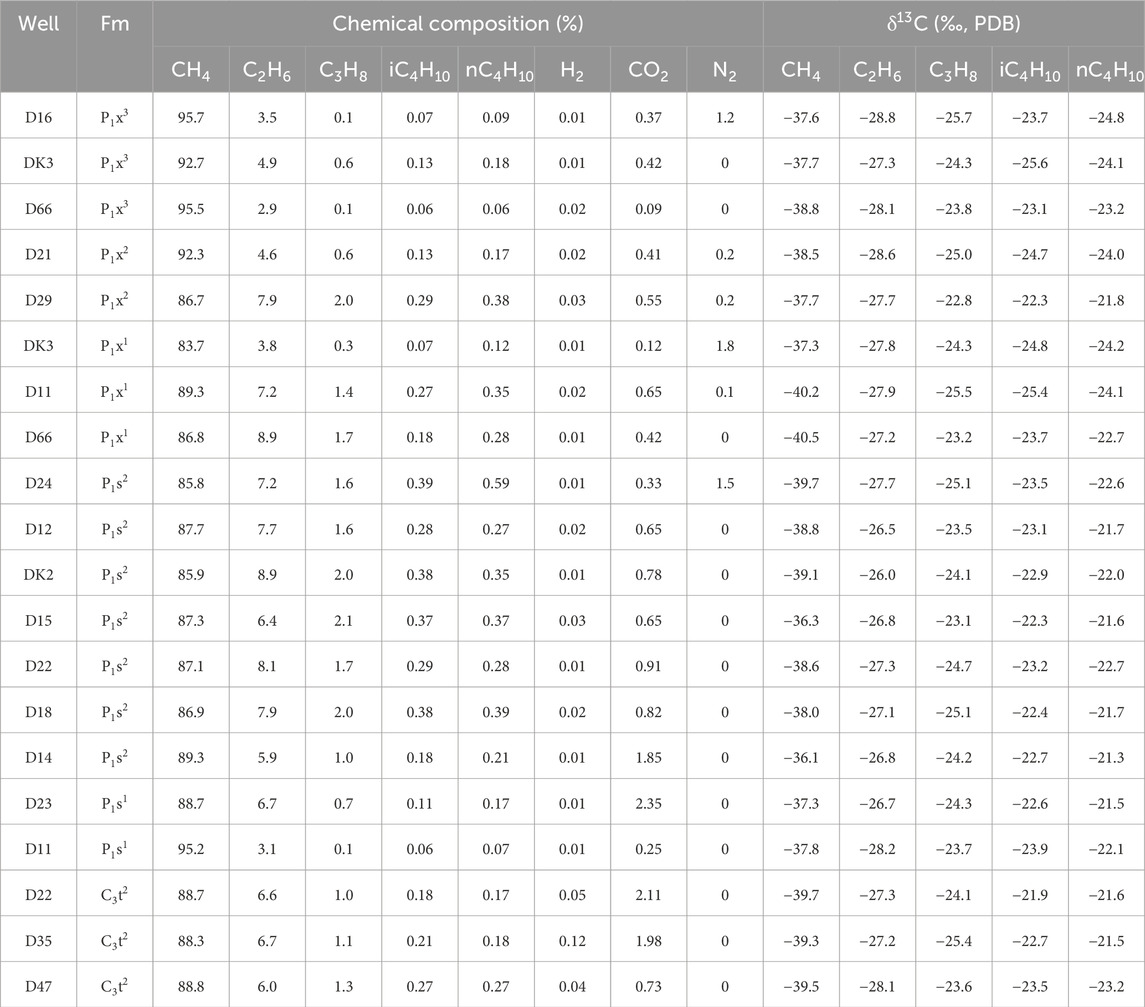
TABLE 4. Chemical and stable isotopic compositions of natural gas from the Upper Paleozoic reservoir in the Daniudi gas field.
Since the Mesozoic, the Ordos Basin has tectonically undergone three periods, i.e., development of gentle, flat structures in the middle Triassic (Indosinian movement period), development of paleo-uplifts in the late Triassic–early Cretaceous (Yanshan movement period) and formation of present-day slopes (Xishan movement period) (Yang et al., 2005; Liu et al., 2016; He et al., 2019). In the late Triassic, the basin quickly subsided, which greatly increased the paleo-geothermal gradient to 33°C–48°C/km. In the late Early Cretaceous, after the strata reached maximum burial depth, they were uplifted, leading to decreased geothermal gradient and formation temperature.
Stratigraphic and tectonic evolutions are comparatively consistent within the Daniudi gas field. According to the thermal maturity history analysis of typical wells (Figure 8), the upper Paleozoic source rocks within the gas field mainly underwent three stages of thermal evolution history, including late Triassic, late Jurassic and Cretaceous–late Paleocene. At the end of the Triassic, the bottom of the Taiyuan Fm had a burial depth of up to 2,500 m, and the source rocks in the bottom entered the maturity threshold, started hydrocarbon generating evolution and subsequently suffered from tectonic uplifting; however, the uplifted denudation volume was small. In Jurassic, source rocks entered the second stage of hydrocarbon generation evolution, evolving into a mature stage with the Ro value reaching up to 1.0%, and then starting to generate a massive amount of hydrocarbon. As a result of the continuous subsidence and sedimentation in the early Cretaceous, source rocks continued their hydrocarbon generation evolution and their Ro values evolved to 1.3% in Carboniferous. Under the fast subsidence and sedimentation during the Late Cretaceous–Paleocene, the source rocks evolved quickly, generated hydrocarbon and entered the third hydrocarbon generation evolution stage, having Ro values exceeding 1.5% and reaching a highly mature stage. Eocene tectonic uplifting terminates the source rock evolution even up to the present. The maximum burial depth of the reservoir was 3,800–4,000 m, and the formation temperature decreased from 170°C to 190°C to the present 80°C–90°C.
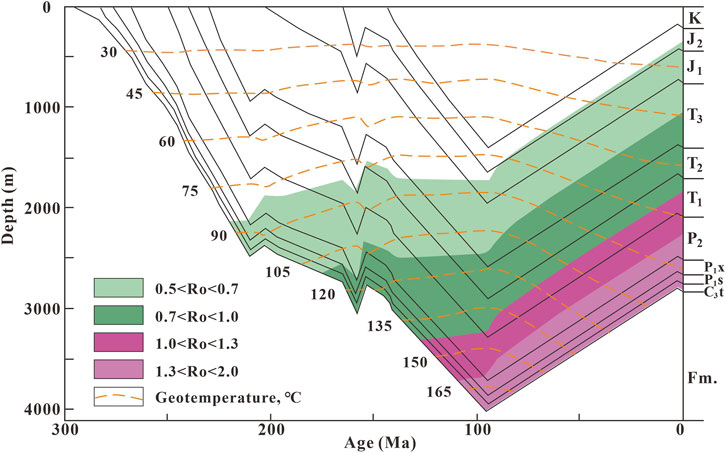
FIGURE 8. Burial history, geothermal history, and maturity history of the strata in the Daniudi Gas Field. The upper Paleozoic source rocks within the gas field mainly underwent three stages of thermal maturity history, including late Triassic, late Jurassic and Cretaceous–late Paleocene.
The upper Paleozoic coal-measure source rocks of the Daniudi gas field have high thermal maturities with Ro mainly varying from 1.2% to 1.5% and Tmax ranging from 460°C to 480°C. The primary pores in the reservoir are hardly exist, the reservoir spaces are minor secondary dissolution pores and microfractures, and the porosities are less than 10%. Clay minerals of the reservoir are dominated by illite/smectite formation, with secondary kaolinite and chlorite; the degree of order of illite/smectite formation varies from 15% to 30%. According to China’s criteria for classification of diagenetic stages of clastic rocks (SY/T 5477-2003), the reservoir is mainly in the middle diagenetic Stage B. The upper Paleozoic sandstone reservoir in the Daniudi gas field underwent complicated diagenetic evolution; the main causes of reservoir densification include long-term mechanical compaction and multistage of siliceous and calcite cementation.
The upper Paleozoic sandstone reservoir has a maximum burial depth of up to 4,000 m and underwent long-term intense compaction. This condition is mainly expressed by the elongated and bent epimetamorphic lithic fragments, the clastic grains orientated in linear or concavo-convex contacts and observable cracks on the surface of some rigid grains. Calculation indicates that the reservoir compaction rate varies from 22.2% to 97.5% and the loss ratio of pores varies from 7.56% to 33.15% with an average of 25.3%. The reservoir has multistage siliceous and calcareous cements as well as minor clay mineral cements, which further compact the reservoir. Microscopic observation indicates that quartz has typical three stages of overgrowth. Stage I quartz overgrowth occurs in one side of the quartz grains (Figure 9A) with small widths (<0.02 mm) and minor quantity; inclusions inside the overgrowth have a homogenisation temperature of 78°C. Stage II quartz overgrowth surrounds the quartz grains (Figure 9B), with large widths and automorphic crystal faces; inclusions inside the overgrowth have a homogenisation temperature of 91.6°C. Stage III quartz overgrowth is mostly in zigzag or sutured linear contacts, with two stages of dust line (Figure 9C); the overgrowth occupies almost all residual intergranular pores, with widths of >0.05 mm and basically no automorphic crystal faces; inclusions have homogenisation temperatures of 112.4°C. The calcareous cement types include early-stage carbonate cements, such as calcite and dolomite, and late-stage carbonate cements, such as ferrocalcite and ferrodolomite (Figure 9D). Microscopic observation indicates that the reservoir has two obvious stages of calcareous cement: Stage I cements are mainly calcite in intergranular pores, which usually occur as thin films along pores and appear yellow in cathode luminescence; Stage II cements are mainly calcite and ferrocalcite in intergranular pores; as a result of the high Fe ion content, the cements show a bright colour (generally bright yellow) in CL, which are greatly different from early-stage cements (Figure 9E). In addition, intergranular pores are filled with argillaceous material and autogenic clay minerals, which is also an important factor for reservoir densification (Figure 9F).
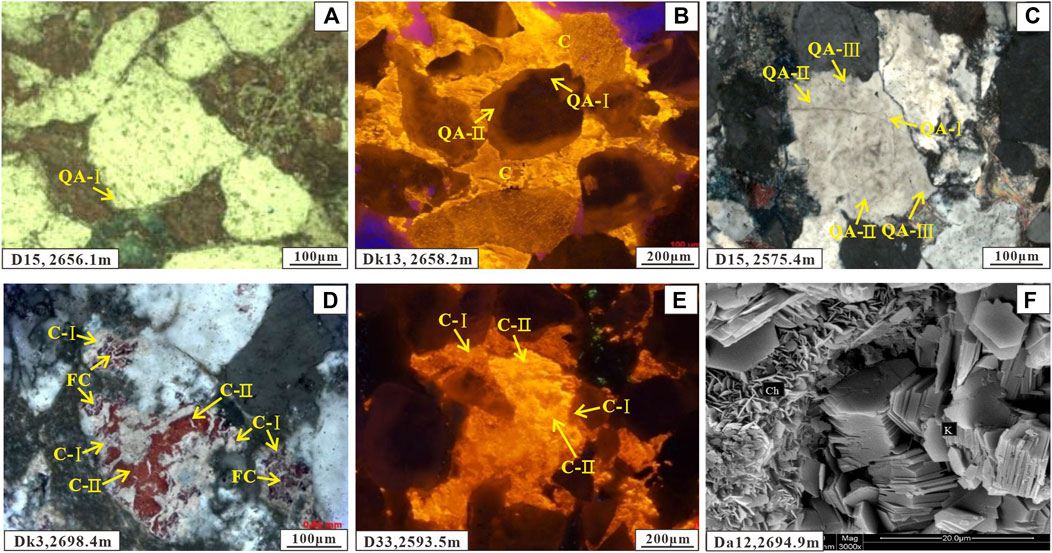
FIGURE 9. The characteristics of cements in the Upper Paleozoic tight sandstone reservoirs. Note: (A), Stage I quartz overgrowth, Single Nicol; (B), Stage II quartz overgrowth unevenly encircled quartz grains, Cathodoluminescence image; (C), Three stages of quartz overgrowth, Crossed Nicol; (D), Carbonate cements formed in two stages, Crossed Nicol; (E), Two stages of carbonate cements, Cathodoluminescence image; (F), kaolinite and chlorite occlude primary pores, SEM image. Q–quartz; QA–authigenic quartz; K–kaolinite; Ch–chlorite; C–calcite.
The upper Paleozoic tight sandstone reservoir in the Daniudi gas field underwent complicated diagenetic evolution (Figure 10), including fast burial compaction, diagenetic evolution in acid–alkaline fluid environments and strongly cemented densification stages. Compaction in the early diagenetic B stage decreased the reservoir porosity by 15%–20%. Quartz overgrowth formed from the early diagenetic B stage to the middle diagenetic A2 stage under formation temperatures of 80°C–130°C and an acid fluid environment, decreasing the porosity by 5%–10%. Carbonate cements usually occurred when the fluid environment turned alkaline after quartz enlargement rims were formed, which decreased the porosity by 3%–5%. The finalisation of reservoir densification is ∼140 Ma BP (early Cretaceous), the formation temperature was ∼130°C and Ro was 0.8%. Under intense diagenetic reworking, reservoir properties showed very strong anisotropism in space, and natural gas in the reservoir hardly migrated because of buoyancy.

FIGURE 10. Diagenetic evolution sequence of the Upper Paleozoic sandstone reservoirs in the Daniudi Gas Field. The upper Paleozoic tight sandstone reservoir in the Daniudi gas field underwent complicated diagenetic evolution, generally including fast burial compaction, diagenetic evolution in acid–alkaline fluid environments and strongly cemented densification stages.
Natural gas that has been extracted from the upper Paleozoic in the Daniudi gas field is mostly high-maturity coal-generated gas and mainly composed of CH4 (Yang et al., 2010; Li et al., 2016). According to the C isotope assay results of CH4, the two major gas pay zones in the Daniudi gas field have greatly different CH4 δ13C values (Figure 10; Table 4). In the gas reservoirs of the Xiashihezi Fm in the southwest, methane has δ13C ranging from −36.15‰ to −33.28‰, representing high-maturity natural gas; while in the gas reservoir of the Taiyuan Fm in the northeast, methane gas has low δ13C, ranging from −39.02‰ to −36.58‰, representing low-maturity natural gas. This phenomenon indicates that the two major gas pay zones in the Daniudi gas field have different natural gas accumulation processes. According to the natural gas generation–migration history of the upper Paleozoic in the study area, gas accumulation can be classified into two types, i.e., self-sourced and near-source accumulations.
Self-sourced accumulation mainly occurs in the Taiyuan and Shanxi Fms; in the sedimentary evolution system from barrier coast–tidal flat to delta, the reservoirs mainly include barrier bar sands and distributary channel sands (Liu et al., 2019), and the cap rock is the mudstone in the coal-measure strata, forming a self-generation and self-accumulation system with coal rocks within the interval and dark mudstones. Natural gas that was generated from gas generation centres in the Shanxi and Taiyuan Fm entered the reservoirs quickly. Barrier bar reservoirs have favourable physical properties; thus, continuous natural gas plumes can be formed, providing sufficient buoyancy for natural gas lateral migration. Natural gas migrated towards the northeastern Daniudi gas field and accumulated in favourable lithologic traps. Natural gas accumulation in this stage occurs earlier than the formation of tight reservoirs. Near-source accumulations Near-source accumulation mainly occurs in the Xiashihezi Fm. The source rocks are the underlying Taiyuan Fm and Shanxi Fm coal-measure source rocks; the reservoirs are mainly fluvial facies sands, and the overlying Shangshihezi Fm hugely thick mudstone and the mudstone adjoining reservoirs are the cap rock, forming a lower-generation, upper-accumulation combination. After tight sandstone reservoirs were formed, massive high-maturity gases were generated. However, natural gas migration was difficult because of poor reservoir physical properties and high capillary force. Fractures that formed in the late Cretaceous stratigraphic uplifting provided access for natural gas migration. Natural gas migrated vertically through these fracture beds and accumulated in sandstones with developed fractures. In accordance with the geologic conditions, transportation system, natural gas accumulation tracer, migration force and generation–accumulation combination, the accumulation model of the upper Paleozoic tight sandstone gas reservoir was proposed (Figure 11). Generally, in the period of the Shanxi Fm and Taiyuan Fm, favourable lithologic traps near gas generation centres are the areas with the highest exploration potential.
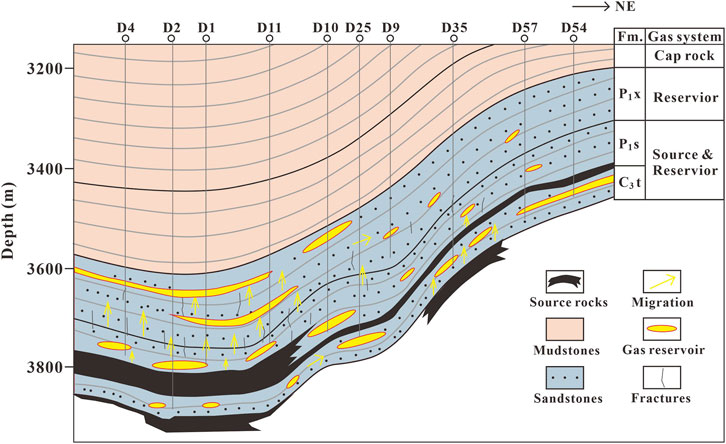
FIGURE 11. Gas accumulation model of the Upper Paleozoic tight sandstones in the Daniudi Gas Field, Ordos Basin.
The upper Paleozoic sandstone reservoir in the Daniudi gas field experienced long-term compaction, multistage quartz cementation and carbonate cementation, which caused the densification of the sandstones. The reservoir has porosity varying from 2% to 12%, with an average of 6.9%, and permeability varying from 0.01 × 10−3 μm2 to 10 × 10−3 μm2, with an average of 0.76 × 10−3 μm2. In various gas layers, reservoirs in the Mbr 2 and Mbr 3 of the Xiashihezi Fm have comparatively favourable properties.
The upper Paleozoic source rocks of the Daniudi gas field are principally coal rocks and dark mudstones; the source rocks are mainly developed in the Taiyuan and Shanxi Fms, the organic type is dominated by III and the source rocks are basically in a highly mature stage. Source rocks of the study area mainly underwent the late Triassic, late Jurassic and Cretaceous–late Paleocene. Thick-bedded source rocks are chiefly distributed in the southwest of the study area, and the Taiyuan and Shanxi Fms source rocks have the maximum quantity of hydrocarbon generation.
In accordance with the coupling relationship between upper Paleozoic sandstone densification and gas generation–accumulation process in the Daniudi gas field, the formation of tight sandstone gas reservoirs can be classified into two types: self-sourced and near-source accumulations. In the period of the Shanxi Fm and Taiyuan Fm, before sandstone reservoir densification occurred, low-maturity natural gas generated from coal rocks and dark mudstones quickly entered the reservoir, migrated northeastwards along conducting sands driven by buoyancy and accumulated in favourable lithologic traps. In the period of Xiashihezi Fm, the tight sandstone reservoir formed; high-maturity natural gas migrated along late Cretaceous fractures and accumulated in the nearby reservoir with abundant microfractures.
The original contributions presented in the study are included in the article/Supplementary material, further inquiries can be directed to the corresponding author.
FS: Conceptualization, Funding acquisition, Methodology, Supervision, Writing–original draft, Writing–review and editing. QK: Methodology, Writing–review and editing, Software. NS: Investigation, Project administration, Validation, Visualization, Writing–original draft, Conceptualization, Funding acquisition. GJ: Resources, Supervision, Visualization, Conceptualization, Funding acquisition, Methodology, Project administration, Writing–review and editing. MX: Methodology, Validation, Software, Writing–review and editing.
The author(s) declare financial support was received for the research, authorship, and/or publication of this article. This study was co-funded by the National Natural Science Foundation of China (41702158), the Natural Science Foundation of Shandong Province (ZR2022MD014) and the Fundamental Research Funds for the Central Universities (18CX02057A).
Author GJ was employed by Xinchun Petroleum Development Limited Company, SINOPEC.
The remaining authors declare that the research was conducted in the absence of any commercial or financial relationships that could be construed as a potential conflict of interest.
All claims expressed in this article are solely those of the authors and do not necessarily represent those of their affiliated organizations, or those of the publisher, the editors and the reviewers. Any product that may be evaluated in this article, or claim that may be made by its manufacturer, is not guaranteed or endorsed by the publisher.
Cai, C. F., Hu, G. Y., He, H., Li, J., Li, J. F., and Wu, Y. S. (2005). Geochemical characteristics and origin of natural gas and thermochemical sulphate reduction in Ordovician carbonates in the Ordos Basin, China. J. Petroleum Sci. Eng. 48, 209–226. doi:10.1016/j.petrol.2005.06.007
Dai, J. X., Li, J., Ding, W. W., Hu, G. Y., Luo, X., Tao, S. Z., et al. (2005). Gas geochemical characteristics on the gas fields reserves of over one hundred billion cubic meters in China. Petroleum Explor. Dev. 32, 16–22.
Fu, J. H., Wei, X. S., and Nan, J. X. (2013). Characteristics and origin of reservoirs of gas fields in the Upper Paleozoic tight sandstone, Ordos Basin. J. Palaeogeogr. 15, 529–538. (in Chinese with English abstract). doi:10.7605/gdlxb.2013.04.042
He, C., Ji, L. M., Su, A., Wu, Y. D., Zhang, M. Z., Zhou, S. X., et al. (2019). Source-rock evaluation and depositional environment of black shales in the Triassic Yanchang Formation, southern Ordos Basin, north-central China. J. Petroleum Sci. Eng. 173, 899–911. doi:10.1016/j.petrol.2018.10.089
Islam, M. A. (2009). Diagenesis and reservoir quality of bhuban sandstones (neogene), titas gas field, bengal basin, Bangladesh. J. Asian Earth Sci. 35, 89–100. doi:10.1016/j.jseaes.2009.01.006
Karim, A., Piper, P. G., and Piper, J. W. D. (2010). Controls on diagenesis of lower cretaceous reservoir sandstones in the western sable subbasin, offshore nova scotia. Sediment. Geol. 224, 65–83. doi:10.1016/j.sedgeo.2009.12.010
Lan, C. L., Yang, M. H., and Zhang, Y. Z. (2016). Impact of sequence stratigraphy, depositional facies and diagenesis on reservoir quality: a case study on the Pennsylvanian Taiyuan sandstones, northeastern Ordos Basin, China. Mar. Petroleum Geol. 69, 216–230. doi:10.1016/j.marpetgeo.2015.09.009
Li, J., Li, J., Li, Z. S., Wang, D. L., Gong, S., Zhang, Y., et al. (2014). The hydrogen isotopic characteristics of the Upper Paleozoic natural gas in Ordos Basin. Org. Geochem. 74, 66–75. doi:10.1016/j.orggeochem.2014.01.020
Li, M., Hou, Y. D., Luo, J. L., Chen, J. P., Luo, X. R., and Jia, Y. N. (2016). Burial, diagenesis, hydrocarbon charging evolution process and quantitative analysis of porosity evolution: a case study from He 8 tight sand gas reservoir of the Upper Paleozoic in Eastern Ordos Basin. Oil Gas Geol. 37, 882–892. (in Chinese with English abstract). doi:10.11743/ogg20160610
Liu, D., Zhang, W. Z., Kong, Q. F., Feng, Z. Q., Fang, C. C., and Peng, W. L. (2016). Lower Paleozoic source rocks and natural gas origins in Ordos Basin, NW China. Petroleum Explor. Dev. 43, 591–601. doi:10.1016/s1876-3804(16)30069-6
Liu, D. K., Sun, W., Ren, D. Z., and Li, C. Z. (2019). Quartz cement origins and impact on storage performance in Permian Upper Shihezi Formation tight sandstone reservoirs in the northern Ordos Basin, China. J. Petroleum Sci. Eng. 178, 485–496. doi:10.1016/j.petrol.2019.03.061
Liu, Q. Y., Jin, Z. J., Meng, Q. Q., Wu, X. Q., and Jia, H. C. (2015). Genetic types of natural gas and filling patterns in Daniudi gas field, Ordos Basin, China. J. Asian Earth Sci. 107, 1–11. doi:10.1016/j.jseaes.2015.04.001
Lu, J. H., and Miao, J. J. Q. Q. (2018). Analysis of the hydrocarbon generation potential of Carboniferous-Permian source rocks of the Daniudi gas field. J. Geol. 42, 60–69. (in Chinese with English abstract). doi:10.3969/j.issn.1674-3636.2018.01.009
Ren, Z. L., Zhang, S., Gao, S. L., Cui, J. P., Xiao, Y. Y., and Xiao, H. (2007). Tectonic thermal evolution history of the Ordos basin and its hydrocarbon accumulation significance. Sci. China. Ser. D. 37, 23–32.
Su, N. N., Song, F., Qiu, L. W., Chen, S. Y., and Zhang, N. (2016). Diagenetic evolution of tight sandstone reservoir in lower Shihezi formation from Daniudi gas field. J. Central South Univ. 47, 3555–3561. (in Chinese with English abstract). doi:10.11817/j.issn.1672-7207.2016.10.036
Sun, L. D., Zou, C. N., Jia, A. L., Wei, Y. S., Zhu, R. K., Wu, S. T., et al. (2019). Development characteristics and orientation of tight oil and gas in China. Petroleum Explor. Dev. 46, 1073–1087. doi:10.1016/s1876-3804(19)60264-8
Wang, J. L., Feng, L. Y., Steve, M., Xu, T., Gail, T., and Mikael, H. (2015). China’s unconventional oil: a review of its resources and outlook for long-term production. Energy 82, 31–42. doi:10.1016/j.energy.2014.12.042
Wu, X. Q., Liu, Q. Y., Zhu, J. H., Li, K., Liu, G. X., Chen, Y. B., et al. (2017). Geochemical characteristics of tight gas and gas-source correlation in the Daniudi gas field, the Ordos Basin, China. Mar. Petroleum Geol. 79, 412–425. doi:10.1016/j.marpetgeo.2016.10.022
Xi, K. L., Cao, Y. C., Jahren, J., Zhu, R. K., Bjørlykke, K., Haile, B. G., et al. (2015). Diagenesis and reservoir quality of the lower cretaceous quantou formation tight sandstones in the southern songliao basin, China. Sediment. Geol. 330, 90–107. doi:10.1016/j.sedgeo.2015.10.007
Yang, H., and Liu, X. S. (2014). Progress in paleozoic coal-derived gas exploration in the Ordos Basin, west China. Petroleum Explor. Dev. 41, 144–152. doi:10.1016/s1876-3804(14)60017-3
Yang, R. C., Fan, A. P., Han, Z. Z., and Wang, X. P. (2012). Diagenesis and porosity evolution of sandstone reservoirs in the East II part of Sulige gas field, Ordos Basin. Int. J. Min. Sci. Technol. 22, 311–316. doi:10.1016/j.ijmst.2012.04.005
Yang, Y. T., Li, W., and Ma, L. (2005). Tectonic and stratigraphic controls of hydrocarbon systems in the Ordos Basin: a multicycle cratonic basin in central China. AAPG Bull. 89, 255–269. doi:10.1306/10070404027
Yang, Z., He, S., Guo, X. W., Li, Q. Y., Chen, Z. Y., and Zhao, Y. C. (2016). Formation of low permeability reservoirs and gas accumulation process in the Daniudi gas field, northeast Ordos Basin, China. Mar. Petroleum Geol. 70, 222–236. doi:10.1016/j.marpetgeo.2015.10.021
Yang, Z., He, S., Zou, C. N., Li, Q. Y., and Chen, Z. Y. (2010). Coupling relationship between reservoir diagenesis and natural gas accumulation of Daniudi gas field in north Ordos Basin. Acta Pet. Sin. 31, 372–385. (in Chinese with English abstract).
Zhang, J. L., Chang, X. C., and Zhang, J. G. (2000). Deep basin gas reservoir research in Upper Paleozoic formation in Ordos basin. Petroleum Explor. Dev. 27, 30–35.
Zhang, L. P., Luo, X. R., Ma, X. H., Chen, M. J., and Wu, M. H. (2007). Diagenetic trap in deep basin gas: taking Yulin gas field in Ordos basin as an example. Chin. Sci. Bull. 52, 679–687.
Zhao, J. Z., Fu, J. H., Yao, J. L., Liu, X. S., Wang, H. E., Cao, Q., et al. (2012). Quasi-continuous accumulation model of large tight sandstone gas field in Ordos Basin. Acta Pet. Sin. 33, 37–52. (in Chinese with English abstract).
Zhao, J. Z., Zhang, W. Z., Li, J., Cao, Q., and Fan, Y. F. (2014). Genesis of tight sand gas in the Ordos Basin, China. Org. Geochem. 74, 76–84. doi:10.1016/j.orggeochem.2014.03.006
Zou, C. N., Tao, S. Z., and Fang, X. (2009). Formation and distribution of large size oil and gas zone. Beijing: Science Press.
Zou, C. N., Yang, Z., Tao, S. Z., Yuan, X. J., Zhu, R. K., Hou, L. H., et al. (2013). Continuous hydrocarbon accumulation over a large area as a distinguishing characteristic of unconventional petroleum: the Ordos Basin, North-Central China. Earth-Science Rev. 126, 358–369. doi:10.1016/j.earscirev.2013.08.006
Keywords: tight sandstone reservoir, diagenesis, gas generating centre, gas accumulation, Daniudi gas field, Ordos Basin
Citation: Song F, Kong Q, Su N, Jiao G and Xu M (2024) Formation mechanism of the upper Paleozoic tight sandstone gas reservoir in the Daniudi gas field, Ordos Basin, China. Front. Earth Sci. 12:1355494. doi: 10.3389/feart.2024.1355494
Received: 14 December 2023; Accepted: 16 January 2024;
Published: 31 January 2024.
Edited by:
Xixin Wang, Yangtze University, ChinaReviewed by:
Zhen Zhang, Chinese Academy of Geological Sciences, ChinaCopyright © 2024 Song, Kong, Su, Jiao and Xu. This is an open-access article distributed under the terms of the Creative Commons Attribution License (CC BY). The use, distribution or reproduction in other forums is permitted, provided the original author(s) and the copyright owner(s) are credited and that the original publication in this journal is cited, in accordance with accepted academic practice. No use, distribution or reproduction is permitted which does not comply with these terms.
*Correspondence: Fan Song, c29uZ2ZhbkB1cGMuZWR1LmNu
Disclaimer: All claims expressed in this article are solely those of the authors and do not necessarily represent those of their affiliated organizations, or those of the publisher, the editors and the reviewers. Any product that may be evaluated in this article or claim that may be made by its manufacturer is not guaranteed or endorsed by the publisher.
Research integrity at Frontiers

Learn more about the work of our research integrity team to safeguard the quality of each article we publish.